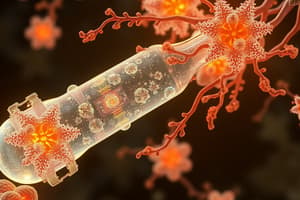Podcast
Questions and Answers
What are endotoxins and pyrogens?
What are endotoxins and pyrogens?
Endotoxins and pyrogens are bacterial products released from live bacteria or after they die. They must be practically free from endotoxins and pyrogens in sterile products.
Why may endotoxins and pyrogens be present in sterile products?
Why may endotoxins and pyrogens be present in sterile products?
Endotoxins and pyrogens may be present in sterile products as a by-product of the sterilization process.
What are particulates and why are they important in intravenous administration?
What are particulates and why are they important in intravenous administration?
Particulates are visible or subvisible particles. They must comply with a particulate contamination test and be free of visible particles and contain only very low numbers of subvisible particles. Particulates are particularly important in intravenous administration as they may result in embolism.
What are the potential consequences of injecting sufficient quantities of endotoxins and pyrogens?
What are the potential consequences of injecting sufficient quantities of endotoxins and pyrogens?
What are the pharmacopoeial requirements for particulates in injectable products?
What are the pharmacopoeial requirements for particulates in injectable products?




